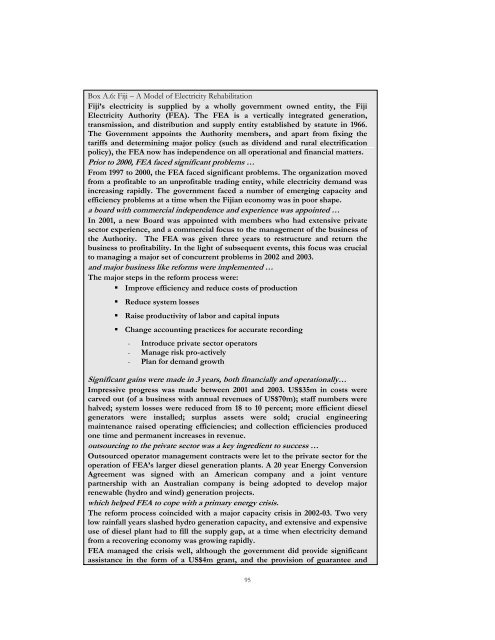EAP - The Pacific Infrastructure Challenge - World Bank (2006).pdf
EAP - The Pacific Infrastructure Challenge - World Bank (2006).pdf
EAP - The Pacific Infrastructure Challenge - World Bank (2006).pdf
Create successful ePaper yourself
Turn your PDF publications into a flip-book with our unique Google optimized e-Paper software.
Box A.6: Fiji – A Model of Electricity Rehabilitation<br />
Fiji’s electricity is supplied by a wholly government owned entity, the Fiji<br />
Electricity Authority (FEA). <strong>The</strong> FEA is a vertically integrated generation,<br />
transmission, and distribution and supply entity established by statute in 1966.<br />
<strong>The</strong> Government appoints the Authority members, and apart from fixing the<br />
tariffs and determining major policy (such as dividend and rural electrification<br />
policy), the FEA now has independence on all operational and financial matters.<br />
Prior to 2000, FEA faced significant problems …<br />
From 1997 to 2000, the FEA faced significant problems. <strong>The</strong> organization moved<br />
from a profitable to an unprofitable trading entity, while electricity demand was<br />
increasing rapidly. <strong>The</strong> government faced a number of emerging capacity and<br />
efficiency problems at a time when the Fijian economy was in poor shape.<br />
a board with commercial independence and experience was appointed …<br />
In 2001, a new Board was appointed with members who had extensive private<br />
sector experience, and a commercial focus to the management of the business of<br />
the Authority. <strong>The</strong> FEA was given three years to restructure and return the<br />
business to profitability. In the light of subsequent events, this focus was crucial<br />
to managing a major set of concurrent problems in 2002 and 2003.<br />
and major business like reforms were implemented …<br />
<strong>The</strong> major steps in the reform process were:<br />
Improve efficiency and reduce costs of production<br />
Reduce system losses<br />
Raise productivity of labor and capital inputs<br />
Change accounting practices for accurate recording<br />
- Introduce private sector operators<br />
- Manage risk pro-actively<br />
- Plan for demand growth<br />
Significant gains were made in 3 years, both financially and operationally…<br />
Impressive progress was made between 2001 and 2003. US$35m in costs were<br />
carved out (of a business with annual revenues of US$70m); staff numbers were<br />
halved; system losses were reduced from 18 to 10 percent; more efficient diesel<br />
generators were installed; surplus assets were sold; crucial engineering<br />
maintenance raised operating efficiencies; and collection efficiencies produced<br />
one time and permanent increases in revenue.<br />
outsourcing to the private sector was a key ingredient to success …<br />
Outsourced operator management contracts were let to the private sector for the<br />
operation of FEA’s larger diesel generation plants. A 20 year Energy Conversion<br />
Agreement was signed with an American company and a joint venture<br />
partnership with an Australian company is being adopted to develop major<br />
renewable (hydro and wind) generation projects.<br />
which helped FEA to cope with a primary energy crisis.<br />
<strong>The</strong> reform process coincided with a major capacity crisis in 2002-03. Two very<br />
low rainfall years slashed hydro generation capacity, and extensive and expensive<br />
use of diesel plant had to fill the supply gap, at a time when electricity demand<br />
from a recovering economy was growing rapidly.<br />
FEA managed the crisis well, although the government did provide significant<br />
assistance in the form of a US$4m grant, and the provision of guarantee and<br />
95

















